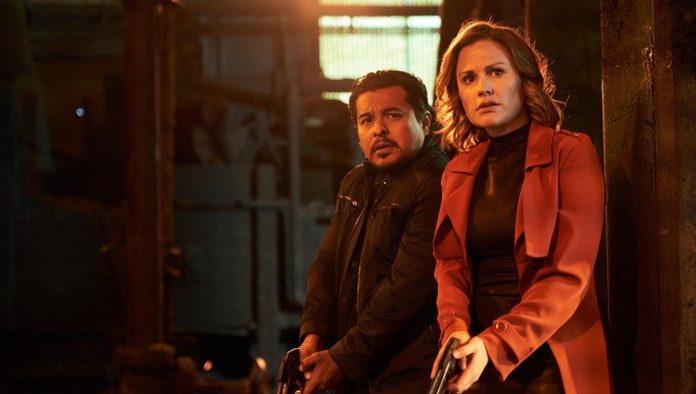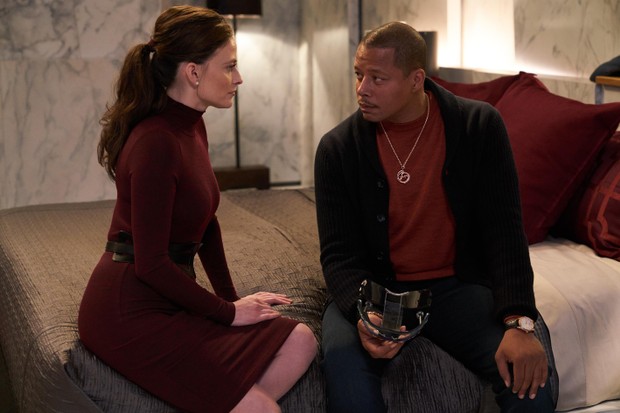
Amazon Sarah (Anna Paquin) and Mario (Jacob Vargas) in Philip K. Dick's Electric Dreams
Philip K. Dick’s Electric Dreams anthology series has debuted on Amazon, with the first six episodes already airing on Channel 4. Real Life is the first episode on Amazon (and the fifth episode broadcast on Channel 4.) It’s a fascinating story that keeps you guessing until the very end. But for some viewers, it’s the ending that has them a little confused. Read on for an explanation of just what happened in this episode. This post, of course, will have major spoilers for the episode “Real Life” in Electric Dreams Season 1. So don’t read on unless you’ve already seen the episode.
Much like the title hints, for the entire episode we’re left wondering exactly which storyline is “real life” (or whether they both possibly could be.) The idea of being tricked into believing your reality isn’t “real” is not a new idea in science fiction. I’ve seen it in many episodes, even some particularly interesting Star Trek and Stargate episodes. But the way the question is carried out in this episode is quite fresh, and I was left with enough tantalizing hints to find myself vacillating from one opinion to the other. Even the end, which seems to answer the question once and for all, is still truly open for interpretation.
On one side we have Sarah, who begins the story. She’s a cop who’s dealing with the aftermath of a crime she couldn’t stop. She lived, but many of her friends (and colleagues) were massacred. We’re not told too many details about the crime, except to note that she’s still pursuing the person who killed everyone, and she was almost killed herself. In a timeline this advanced, I would expect Sarah’s PTSD to be dealt with better, but it doesn’t seem society has advanced enough in this particular field. She has a great relationship with her girlfriend, Katie. But although she constantly insists that her life is far too perfect for her to deserve, the tragedy she dealt with leaves her life with a decidedly imperfect label.
Meanwhile, on the other side we have George Miller, a multibillionaire who founded Avacom in 2012. He’s in the process of developing a prototype for the technology that Sarah uses. He recently suffered a concussion while trying to hunt down the person who killed his wife (also Katie, a clone of Sarah’s partner.) His wife was murdered in a viral video after he refused to give up decryption technology that would have left the entire world unsafe. She was kidnapped while he was having an affair with Paula, and he’s dealing with layers upon layers of intense guilt.
The episode leaves so many tantalizing clues that I was never quite sure which of the two lives is real. They’re both using technology that could legitimately create the other life as a simulation. George’s life is imperfect and messy and dark, which leads the people he’s around (who might otherwise be NPCs) to believe his world is the real one. Sarah doubts her world because it feels too perfect (which, ironically, it isn’t.) Both are suffering grief, depression, and PTSD. At one point George even starts to believe that maybe there’s a way they are both real and he’s missing an important connection.
In the end, we’re shown that it was Sarah’s life that was the real one. George decided not to return to Sarah’s world, realizing that because of his concussion his return would be permanent. Sarah, it turns out, had so much survivor’s guilt that she decided to punish herself forever by retreating to George’s world, where she was depressed and sad, separated from Katie for all eternity. And Sarah can never be retrieved. Katie explains in a monologue that we all think we need to be punished. (Katie’s monologue was the only part of the episode that felt “off” to me. It didn’t fit with the rest of the dialogue and seemed stilted. Maybe that’s making me doubt the official ending even more.)
So that’s the explanation we’re given for the ending. But some viewers are still doubting. Is it possible that George made the right decision, and we’re just seeing the aftermath played out in the simulation too? Or, even more strangely, is it possible that both worlds truly are somehow real? While I was watching the episode, my husband had an interesting idea. Maybe George’s story was real, and he planted it in the technology so that the people who used it for years to come would always remember what happened to his wife. Wouldn’t that have been an interesting twist?
One clue that doesn’t make sense is when Sarah entered the warehouse for the first time and commented that it felt familiar. George had been in the warehouse before, and that was why it felt familiar to her. But how on earth could Sarah’s mind create a perfect recreation of a warehouse that she had never actually visited before? This, by itself, might point to both realities actually being “real.”
In the episode, we’re handed the explanation that Sarah’s world was the real one. But we’re left to decide for ourselves — much like George and Sarah had to — if we believe that explanation. In the end, it the imperfections balanced the perfections, and both realities felt “real.” With all this doubt and conjecture, I can say — quite assuredly — that this simulation is pretty much the worst game ever. George’s company will be facing some huge lawsuits if it really can cause permanent brain damage like we see in the episode.
What did you think of the episode? Let us know in the comments below.
